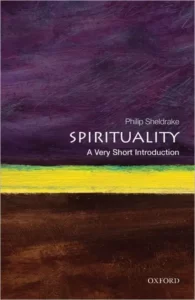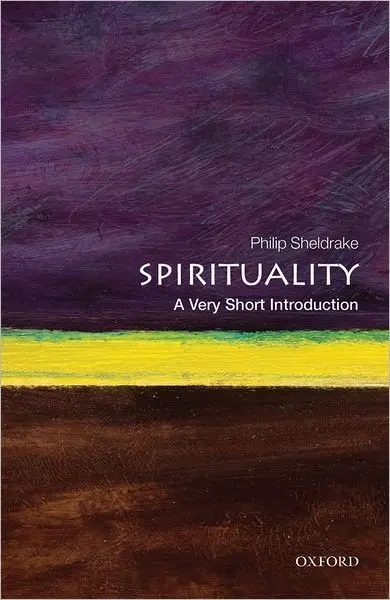
A Very Short Introduction: Spirituality by Philip Sheldrake
An overview of ‘What is Spirituality’, its origins, definitions, the emergence of contemporary spirituality, spiritual types in practice and attending to this day, this age: secular spirituality. Is religious spirituality in the process of being replaced? What is the value of spirituality? How do we deal with different kinds of spirituality such as Engaged Buddhism, Cyberspace and Spirituality, and the forms of mysticism? All this is examined in this small tome.
Consider the following list of spiritualities:
- Jewish Spirituality
- Christian Spirituality
- Islamic Spirituality
- Hindu Spirituality
- Buddhist Spirituality
- Neopagan Spirituality
- Esoteric Spirituality
- Secular Spirituality
- Philosophy overlapping spirituality
- Influence of Psychology and Psychotherapy
- Influence of Gender and Sexuality
- Influence of Aesthetics and the Arts
- Science and Spirituality (consider Teilhard de Chardin)
The problem with presenting a list like the above is that practice is different. There are many streams of practice in Judaism, Christianity, Islam, Buddhism, Hinduism and even Neopagan spirituality has different forms of spiritual practice. Such a list is only a list of headings. We need to look to defining elements of spirituality.
First, spirituality is inherently related to context and culture. The way we talk about spirituality reflects the priorities of the different contexts in which it is used. For example, the dominant themes are different in health care and education. Equally, spirituality has a distinct focus and forms of community building in Africa, Asia, and Latin America as opposed to Europe or North America.
Second, despite these varied approaches, there are certain ‘family resemblances’ which make it possible to offer a tentative definition of spirituality. Thus we sense that spirituality concerns a fully integrated approach to life (holism), involves a quest for the ‘sacred’, underpins a desire for meaning, and implies some understanding of human identity, purpose, and flourishing. Finally, spirituality points to a desire for ultimate values and involves the intentional pursuit of a principled rather than purely pragmatic way of life.
Third, contemporary approaches to spirituality take many forms partly because spirituality has become egalitarian or at least anti-authoritarian. People on a spiritual quest often reject traditional sources of authority and their association with fixed dogmatic systems in favour of the authority of personal, inner experience. This gives rise to the self-description, “I am spiritual but not religious.” This makes it increasingly common for people to borrow from more than one spiritual tradition and even to talk about ‘double belonging’ – ‘I am Christian and Buddhist’.
One of the shining strengths of this book is the descriptions of the spiritual types – the ascetical type, the mystical type, the active-practical type and the prophetic-critical type. These typologies are interpretations of practice rather than formal reality or descriptions.
The Ascetical Type
The words ascetic and asceticism derive from the ancient ascesis, which means training or discipline. In terms of where, how and what, this type sometimes prescribes special places such as the wilderness, the monastery or the ashram, and is characteristically described as practices of self-denial, austerity, and abstention from worldly pleasures as the pathway to spiritual enlightenment.
The Mystical Type
The adjective ‘mystical’ and the noun ‘mysticism’ derive originally from the ancient Greek mystikos which broadly means secret or connected with religious mysteries. These days, mysticism is often taken to refer to anything esoteric or deeply mysterious, especially if it promises special insights and enlightenment or experiences such as an oceanic sense of connectedness to the cosmos or trance-like states and visions.
The mystical type of spirituality is often associated with intuitive ‘knowledge’ of the sacred beyond discursive reasoning; and analysis The end-product is a transformation of consciousness (enlightenment or illumination) and a sense of connection to the ultimate depths of existence.
‘Mysticism’ is present in some way in all of the world religions. It arises from the practice of religious faith with particular intensity. That is to say, religious adherents do not set out to become ‘mystics’ but rather to engage with their Islamic, Hindu, Christian, or other spiritual paths with a particularly intense commitment. This often involves extensive contemplative practice.
The Active-Practical Type
This type of spirituality in a variety of ways, and with qualifications, promotes the ordinary human world and everyday life as the principal context for the spiritual path and for the quest for authenticity.
This type of spirituality is present in various ways in all the world faiths, for example, in the religious humanism of the Hindu Vedanta (seen in the philanthropic work of the Ramakrishna Mission), in similar trends in parts of Buddhism, in varieties of Christian humanism from the Middle Ages onwards, and in the spirituality of service and of ‘finding God in all things’ associated with St. Ignatius Loyola in the 16th century.
The active-practical type of spirituality seeks to find spiritual meaning and orientation through the medium of everyday experiences, commitments, and activity. This type of spirituality emphasises the spiritual value of such human virtues as acceptance, forgiveness, compassion, tolerance, charity, social responsibility, and freedom from egocentrism. It also frequently promotes the disinterested service of our fellow human beings as a form of spiritual practice in itself.
The Prophetic-Critical Type
Prophetic-critical forms of spirituality go beyond the practical service of our fellow humans in the direction of an explicit social critique and a commitment to social justice as a spiritual task.
This draws on the rejection of class and the lifestyle taken up by Siddhartha Gautama (the Buddha), the Old Testament Prophets, the mendicant movement started by St Francis of Assisi, and the critique of the social order taken up by the Anabaptists and Quakers.
“Be the change you want to see in the world” … this statement by Mahatma Gandhi is the lodestone of prophetic-critical spiritual practice. Dietrich Bonhoeffer’s radical Christian witness during World War II, the martyred Oscar Romero in South America, the emergence of Liberation Spirituality, the preaching of Martin Luther King, the rise and validity of feminist spirituality and piercing relevance of eco spirituality are all forms of prophetic-critical spirituality.
There is a brief account of secular spiritualities, spiritual traditions, the development and life-cycle of traditions. Spiritual practices such as rituals, liturgy, fasting and abstinence are also discussed. The influence of sages, saints, sants and pirs are also examined along with “secular saints”.
A key issue in spirituality is experience: if there is no experience of the divine, then what is spirituality? In this wise, there is an examination of Jewish mysticism, Christian mysticism, Islamic mysticism, Hindu mysticism, Buddhist mysticism, along with esoteric mysticism. Thereafter, there is an examination of spirituality as a way of life, spirituality and life development, spirituality and transformation, followed by spirituality-death-and-destiny.
Spirituality in society is taken up by way of examining prophetic-critical types in action, political spirituality, liberation spirituality, Engaged Buddhism, social and public values, spirituality and healthcare, economics, and an examination of cyberspace and spirituality.
For a small book, this is a strong examination of spirituality as it emerges in Western Europe, Asia and North America. Lacking inclusion is coverage of indigenous spirituality, and an examination or brief inclusion of Pagan/Wiccan and Celtic forms of spirituality. In this day and age of spiritual but not religious, atheism and humanism are often mentioned as alternate forms of spiritual practice. There might have been some consideration of the Staretz, the great spiritual practitioners of the Orthodox tradition.
One issue that is looming the the field of spirituality is ageing, spiritual care of the aged, spiritual care in palliative care … these matters reflect the worldwide task of caring for the post-war baby boom as they enter their senior years with all the side-effects of ageing, memory loss, loss of mobility, being bedridden.
![]()


